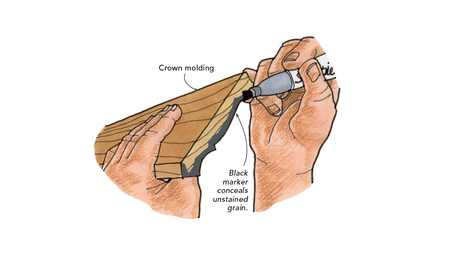
In my lengthy career as an architect, one of the things I learned is where to put the doorstop so that the doorknob does not hit the wall. Most folks think it should go on the baseboard at the bottom of the wall. However, the doorstop — and it should be the solid-steel type — should go on the door so that it hits the baseboard. My preferred position is 2 in. above the floor and 2 in. in from the strike-plate side of the door. In this position, it is never in the way of floor-cleaning equipment.
Sam B. Lewis, Lockhart, TX






























View Comments
Lewis must be an old-school architect- modern hollow-core doors are mostly air at a point 2" in from the strike-plate side and 2" above the floor.
This was in the June/July, 2000 issue. Yes, fewer air and cardboard doors then. (Also, I am not related to BobboMax.)
I "Disagree" in a Way with BobboMax in that I "Often" use Doorstops @ the Top of the Door. Hollow "Core" Doors have an Interior frame the Faces are Glued to and Putting the Door Stop on the Top of the Door sometimes Works Best.
The one "Problem" is Top Mounted Stops need to Hit Drywall over a "Stud". You Might NOT be able to do this if the Closest Stud won't Stop the Interior Door Handle from Hitting Drywall with nothing Behind it.
I "Retrofit" Doors for Handicapped People in Wheelchairs and I Use Wide-Opening Hinges to "Open the Door" Out of the Door Frame. I often Have To Replace the "Inside" Door Knob with a Handle for this. Changing "Placement" of the Doorstop is also "Often Required" so Wheelchairs CAN Go Thru the Door Opening.
Actually, hollow cores don't have an internal frame- see http://www.instructables.com/id/How-to-Build-a-Home-Office/step1/Anatomy-of-a-Hollow-Core-Door-Slab/
That link shows an "old-fashioned" hollow core- the honeycomb is about 2" on center. I hand to sand a modern one recently & the core telegraphed because it was stiffer than the veneer- I could see a 6" diamond pattern that got sanded a little harder than the unsupported area. (FWIW, this was a really cheap door.) The image in the link does omit the area where the surround frame is thickened for the latch.
A stop at the top of the door would work fine as long as it's close enough to the top & the edge to catch the frame, but that's a pretty small area. Try checking it out w/ a stud finder.
I seem to recall the solid lumber edges of interior HC doors is a minimum of 1-1/16". YMMV.
I Still prefer the spring type door stop on the baseboard. The only reason is that it provided and still does provide an endless source of entertainment for the kids. Just love the sound it makes when you bend it back and let it go...
Ha ha! Well said!
Like you're the first one that has thought of this, and scientifically figured out the best location? I've had to remove and relocate a countless number of these to the wall because some genius has decided it would be better to locate on the door.
While I don't disagree with your logic, people very simply end up kicking them with their feet when they go to open the door, aside from the fact they take away from the aesthetics of the door itself (however I have seen many doors where the latter makes little difference, especially if they're hollow core). Which is why they've been installed on the wall for oh I don't know... Centuries.
I prefer the "hang on the hinge pin" kind. They are very adjustable and only once in a while, you have to tap the pin back down. They are 6'8" off the ground and unobtrusive. If the casing is a little loose they give a small spring back. Be sure to adjust for the overpush since it is possible to 'bend' the door beyond the stop point. These also work when the door opens onto glass shower doors or merely shower curtains.
Seeing that it is from Issue 164, it is a pretty old and outdated tip.
FHB should really pay more attention...
Wow! Some people sure get exercised over this stuff!
I recall an early article –– I think FWW, pre FHB -- article in which the author made the analogy to a baseball bat's sweet spot.
Ever hit the ball on the handle, or on the end? No good will come of it! This author picked a spot about 2/3 down the length of the "bat", IIRC, as the point to locate the stop. That is, 2/3 of the way from the hinge side to the latch side.
Other than that recollection I dredged up from back when cave men were babies, I ain't diving in to the surpringly-impassioned debate above.
Obviously very late to the party here...
"it is never in the way of floor-cleaning equipment."??
Does that imply nobody cleans directly behind the door when it is closed?!?!?
I am leaving my door stops on the baseboard where is more aesthetic and out of the way. Who walks along the wall behind the door anyway???